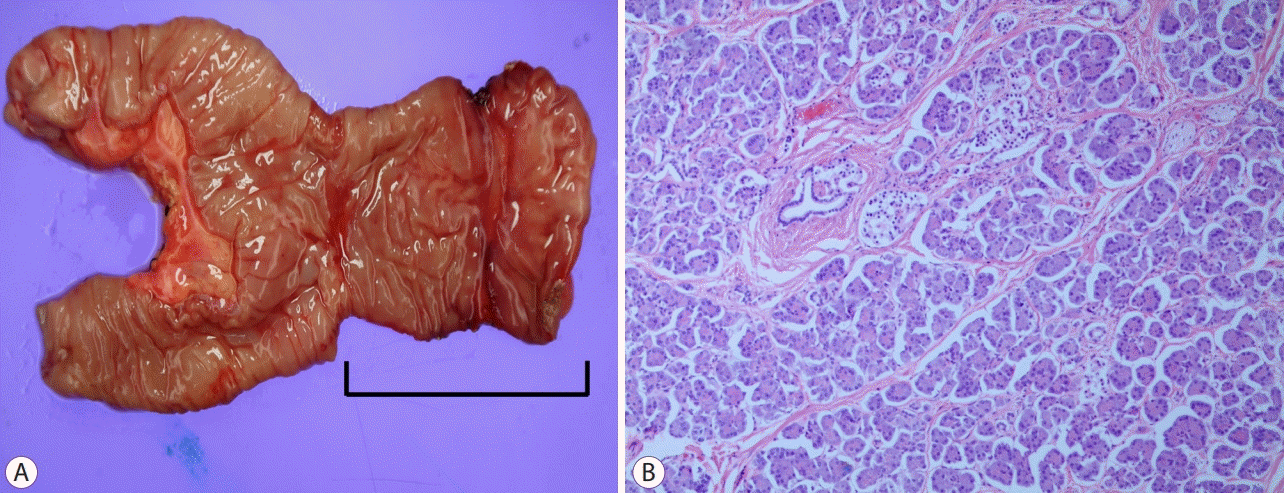A Rare Case of Massive Hematochezia
Article information
Quiz
A 20-year-old man was admitted to the hospital with a 3-day history of intermittent hematochezia. Four weeks prior to presentation, he was prescribed antibiotics and non-steroidal anti-inflammatory drugs for 2 weeks for tonsillitis. The patient’s vital signs were stable; however, physical examination revealed conjunctival pallor, a soft abdomen, and mild tenderness on the lower side of the abdomen. The patient’s baseline laboratory results were as follows: hemoglobin concentration, 7.2 g/dL (reference range, 13.3–16.5 g/dL); white blood cell count, 18,600/μL (3,800–10,000/μL); platelet count, 323,000/μL (140,000–400,000/μL); blood urea nitrogen, 22.1 mg/dL (9.0–23.0 mg/dL); and C-reactive protein, 0.236 mg/dL (0–0.500 mg/dL). The levels of other biochemical tests were within normal ranges. Upper gastrointestinal (GI) endoscopy showed no bleeding, whilst colonoscopy showed blood clots up to the terminal ileum; however, no causative lesion was observed (Fig. 1A and B). Abdominopelvic computed tomography did not show extravasation of the radiocontrast media from the GI tract (Fig. 1C). Capsule endoscopy was performed to identify the bleeding source, which showed linear bleeding ulcers in the distal ileum (Fig. 1D). On the third day of hospitalization, the patient presented with massive hematochezia (>1.5 L) and unstable vital signs. Therefore, an emergency surgery was performed. Intraoperative endoscopy revealed continuous bleeding from a circular linear ulcer with a double-lumen sign located 90 cm above the ileocecal valve (Fig. 1E and F).

(A, B) Colonoscopy revealing blood clots up to the terminal ileum without identifying a lesion as a source of the bleeding in the large bowel. (C) Abdominopelvic computed tomography scan showing no evidence of active contrast extravasation. (D) Capsule endoscopy showing bleeding linear ulcers in the distal ileum. (E, F) Endoscopic findings during surgery reveal continuous bleeding from a circular linear ulcer with a double-lumen sign.
What is the most probable diagnosis?
Answer
The patient underwent segmental small bowel resection 10 cm proximal and distal to the diverticular opening, handsewn end-to-end anastomosis, and endoscopic examination through the small bowel, before he was finally diagnosed with a bleeding 4-cm Meckel’s diverticulum (Fig. 2A). Histological examination of the specimen showed ectopic pancreatic tissue in the diverticulum (hematoxylin and eosin stain, ×100; Fig. 2B).

(A) Macroscopic specimen from the surgical resection revealing circular. (B) Histologic examination showing ectopic pancreatic tissue in the diverticulum (hematoxylin and eosin stain, ×100).
Meckel’s diverticulum is the most common congenital anomaly of the GI tract. It results from incomplete obliteration of the omphalomesenteric duct and is usually located within 60–100 cm from the ileocecal valve [1,2]. Although Meckel’s diverticula are usually asymptomatic, those presenting with symptoms will usually experience these in childhood. Symptoms will present before the age of 2 years in about 45% of symptomatic cases, with the occurrence of symptoms decreasing with age. The main clinical presentations of a symptomatic Meckel’s diverticulum include GI hemorrhage, intestinal obstruction, and diverticulitis with or without perforation. GI bleeding occurs mainly in children, whereas the main symptom in adults is intestinal obstruction [3]. The clinical predisposing factors to symptom development in a patient with Meckel’s diverticulum include age <50 years, male sex, diverticulum length >2 cm, and the presence of histologically abnormal tissue such as gastric mucosa, pancreatic cells, and colonic mucosa [4,5]. GI bleeding related to Meckel’s diverticulum is usually painless acute or chronic bleeding that may become massive. GI bleeding is associated with the presence of ectopic gastric or pancreatic mucosa within the diverticulum. Strong gastric acid or pancreatic alkali secretions from these ectopic mucosa could lead to the formation of ulcers in the adjacent ileal mucosa and subsequent bleeding [3].
Meckel’s diverticular bleeding is diagnosed by various investigations such as a Meckel’s scan (technetium-99m pertechnetate scintigraphy), capsule endoscopy, balloon-assisted enteroscopy, and angiography. A Meckel’s scan can be performed in patients with a high likelihood of Meckel’s diverticulum that are hemodynamically stable with mild or intermittent GI bleeding. This noninvasive scan, which has few side effects, is performed to identify areas of ectopic gastric mucosa because of its affinity for gastric mucosa. However, the diagnostic accuracy of a Meckel’s scan has been reported to be much lower in adults than in children. False negatives may occur due to very small or absent ectopic gastric mucosa in the diverticulum, sudden bleeding, or decreased scintigraphic activity due to intestinal hypersecretion [6]. Capsule endoscopy and balloon-assisted enteroscopy can be used in patients with unexplained intestinal bleeding to identify if the cause is due to a Meckel’s diverticulum. Angiography may detect the omphalomesenteric artery branching off the superior mesenteric artery, which is characteristic in a Meckel’s diverticulum [7]. According to a multicenter retrospective study in Korea, the diagnostic accuracy of Meckel’s diverticular bleeding in adults was 21.4% for Meckel’s scan, 35.7% for capsule endoscopy, 85.0% for balloon-assisted enteroscopy, 31.8% for computed tomography, 62.5% for small bowel follow-through, and 0.0% for angiography [8]. Therefore, balloon-assisted enteroscopy showed the highest diagnostic accuracy among various diagnostic modalities in adults. Meckel’s diverticulum associated with complications, such as GI bleeding, is usually treated surgically by simple diverticulectomy or segmental small bowel resection and primary anastomosis [1,2].
Notes
Conflicts of Interest: Sung Chul Park is currently serving in KSGE Publication Committee; however, Sung Chul Park was not involved in the peer reviewer selection, evaluation, or decision process of this article. Other authors have no potential conflicts of interest.
Funding
None.
